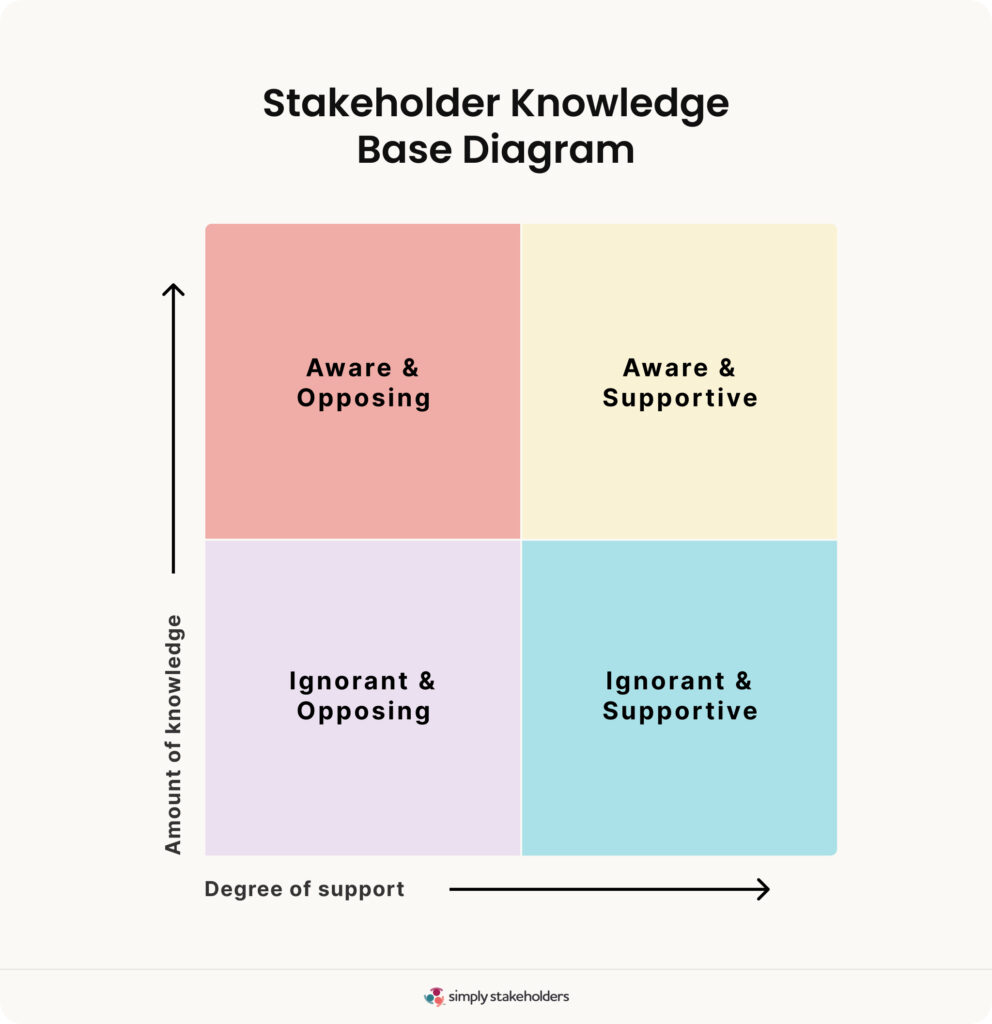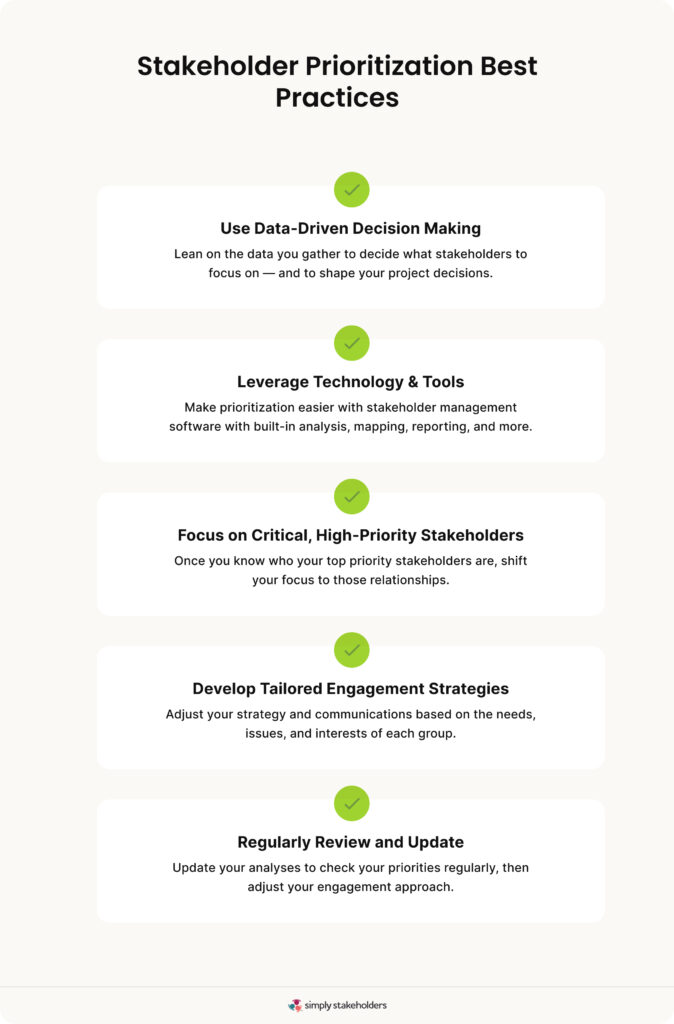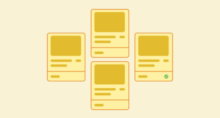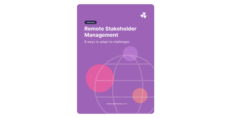Stakeholder Prioritization: Best Practices for Maximizing Impact

Want to get better at prioritizing stakeholders? Perhaps you’re working on your stakeholder analysis or stakeholder plan — or you’re already actively managing your stakeholders. And you’ve run into a very common issue…
You have a large list of potential stakeholders (often across many diverse groups) and limited resources, time, and attention to devote to them.
That’s where stakeholder prioritization comes in! It forms a key part of stakeholder planning, strategy, analysis, and classification — and if you’re a project manager, engagement professional, or part of a consultation team, you should know how to prioritize your stakeholder list.
In this guide, we define what stakeholder prioritization is, why it’s worth doing, popular methods and processes, challenges, and best practices.
Understanding Stakeholder Prioritization
There are two ways to look at stakeholder prioritization.
Firstly, it can mean that stakeholders matter and are a high priority in your organization because engaging with them is critical to the success of your projects. The importance of stakeholders is something we’ve talked about previously. Engaging with your stakeholders is key to making better decisions, minimizing risk, and other advantages.
However, the definition of stakeholder prioritization that we’ll be focusing on in this guide refers to the act of prioritizing your relationship and engagement with some stakeholders over others. Because not all stakeholders require the same level of engagement or focus as others.
Stakeholder prioritization ensures that your limited resources for the consultation can have the greatest potential impact and benefit, even if you can’t reach every stakeholder or engage with them directly.
It involves identifying which stakeholders or groups are most critical to engage with. And in order to do that, you need to identify what criteria matters most for your work so that you can use this criteria to evaluate your list of stakeholders and determine which relationship you need to focus on first, and who to devote more time engaging with.
Benefits of Prioritizing Stakeholders

Before we explore some techniques for prioritizing stakeholders, let’s expand on why it’s a good idea to prioritize your stakeholder list.
Enhanced Relationships and Greater Trust
Best practice stakeholder engagement tends to lead to stronger relationships and higher levels of trust. But when you start with stakeholder prioritization, you can make sure that the relationships you focus on first are those that will have the greatest potential impact on outcomes.
Plus, once you gain the trust of key stakeholders, everything can flow more smoothly with more information sharing, more open communication, and greater support for your decisions.
Efficient Resource Allocation
When you identify stakeholder needs and your priority stakeholder groups from the start, you can make sure the right person gets the right resources, at the right time. This is especially important in situations where you have very limited resources (time, energy, tools, space, funding, access) and multiple stakeholders making a claim on them.
If the project outcomes depend on certain stakeholders getting access to specific tools or resources, or a stakeholder has a right to access those resources for other reasons, you’ll need to prioritize resource allocation accordingly.
Risk Mitigation and Conflict Resolution
In some cases, your top priority stakeholders will be those that present the greatest risk — if you don’t engage with them effectively and gain their support. Prioritizing these stakeholders in your engagement can help you identify risks ahead of time so that you can take steps to avoid them. But it also means you can build key relationships that will help carry you through challenges and resolve conflicts if they arise.
Competitive Advantage and Reputation Building
Lastly, sometimes prioritizing specific stakeholders can give your organization a competitive advantage due to their relationships, support, resources, expertise, or involvement.
For instance, if you can get a well-known and respected individual or group to endorse your work or get involved in your project, this can help give your brand a reputation boost and help to increase social acceptance within the community.
Key Techniques for Stakeholder Prioritization
Stakeholder professionals and project managers can use a range of stakeholder diagrams and methods to understand, analyze, and categorize stakeholders. The following list includes some of the most popular options and how they’re typically used.
Power-Interest Grid

The Power-Interest Grid is a popular model for mapping and analyzing stakeholders (especially if you need to identify influential stakeholders). It uses a matrix to show stakeholder positions and how to engage with them based on their level of power/influence and interest.
Some would argue that stakeholder priority could be expressed as a relationship between the influence/power of a stakeholder group and their interest in the relationship. The idea is that key stakeholders are those with both high power and high interest.
However, in our experience, it’s not that simple. Power is tricky to define these days (many people can tap into power via social media!), and there are many other characteristics and criteria that could make someone your top priority, such as specific interests, support, relationships, and sentiment. If you’re going to use the Power-Interest Grid, you’ll need to incorporate other techniques, too.
Check out our downloadable Power-Interest Grid template here.
Salience Model

The Salience Model is another popular option, often used to understand which stakeholders matter and why. The venn diagram allows you to plot the location of stakeholders according to their levels of power, legitimacy, and urgency. This results in seven categories that supposedly determine whether a stakeholder is priority 1 (definitive), priority 2 (dominant, dangerous, dependent), or priority 3 (dorman, discretionary, demanding).
Like the previous technique, the Salience Model oversimplifies stakeholder attributes, lacking important criteria needed to genuinely prioritize stakeholders. As mentioned previously, the focus on power isn’t necessarily helpful, and there’s also some outdated/offensive language used. If you choose to use this technique, we recommend including other models alongside it and seeing if you can adapt the terms to be more appropriate for a modern setting.
Check out our downloadable Salience Model template here.
Stakeholder Knowledge Base Diagram

The Stakeholder Knowledge Base Diagram is another popular model that could be used to prioritize your stakeholders based on their degree of knowledge and support. Theoretically, stakeholders with high awareness and low support might be considered risky, and therefore, a higher priority for your engagement.
But like the previous techniques covered here, it only focuses on very limited criteria. And some of the wording used (like ignorant) isn’t the nicest! Once again, if you’re going to use this chart, you’ll likely want to incorporate some other models that cover other criteria, too.
Multi-Dimensional Stakeholder Mapping

Out of all the techniques here, the Multi-Dimensional Stakeholder Mapping Method is our favorite. And that’s not just because it’s our proprietary stakeholder mapping methodology! We recommend this approach because it allows you to assess your stakeholders based on six flexible criteria points.
We’ve built this method into our Simply Stakeholders software, including the following default criteria:
- Influence: How likely will the project be influenced by the individual, community, or workplace?
- Interest: To what degree will their specific interests (cultural, social, economic) in the project be affected?
- Impact: How likely is it that the project will impact the individual, community, or workplace?
- Criticality: How critical is the stakeholder to the success of the project?
- Effort: How much effort will it take to engage the stakeholder?
- Position: What is the stakeholder’s position towards the project?
Users can adjust the criteria labels inside Simply Stakeholders to reflect their preferred criteria for prioritizing stakeholders. The attributes can be represented on scatter plots, pie graphs, or stacked bar graphs to visualize the data, with any updates to stakeholders (like an increase in criticality or a shift in position) automatically reflected in the linked stakeholder maps and diagrams.
Check out our downloadable Multi-Dimensional Stakeholder Mapping template here.
Prioritizing Stakeholders in 4 Steps

Now that we’ve talked about some of the tools and techniques you might use to prioritize stakeholders, let’s go through a step-by-step process you can use to figure out who your top priority stakeholders are.
1. Identify Stakeholders
Before you can prioritize your stakeholders, you need a comprehensive list of who your stakeholders are.
Remember, ‘stakeholder’ means any groups, individuals, or organizations that may be impacted by your work or have an influence on it. Plus, anyone that has an interest in your project, policy, initiative, or organization.
If you have access to a stakeholder system like Simply Stakeholders, record your list of stakeholders inside your stakeholder register.
2. Determine Your Criteria
As part of the stakeholder identification process, note down any criteria that may be relevant to prioritizing your stakeholders. You’ll need this criteria in the next step.
Most literature on stakeholder identification agrees that those stakeholders who have power, legitimacy, and urgency over an organization should be prioritized (in other words, the Salience Model we covered above). However, this isn’t necessarily true in every situation.
Other literature proposes a broader set of criteria that could be used to prioritize stakeholders, including:
- Level of interest
- Level of influence
- Magnitude of impact
- Probability of impact
- Urgency/temporal immediacy
- Proximity
- Economic interest
- Rights
- Fairness
- Underrepresented/underserved populations
Our default mapping criteria inside Simply Stakeholders includes influence, interest, impact, criticality, effort, and position. However, we’ve built flexibility into the system, allowing users to adjust the criteria to measure what matters most for their consultation.
To determine your list of criteria, consider what characteristics make it critical for you to engage with, consult, or build a relationship with one stakeholder over another. This will likely vary based on the type of work you’re doing, any regulations surrounding it, and the expectations of your stakeholders.
3. Analyze Stakeholders and Interests
Next, you’ll need to analyze your stakeholder list according to the criteria you identified in the previous step. Depending on what system you’re using, you may need to assign a rating to each stakeholder for each of the criteria. For instance, you might assign a score from 1-5 across influence, interest, and impact — or a rating of low, medium, or high. This will allow you to objectively categorize and rank your stakeholders in step four.
Another popular tool for rating and analyzing stakeholders is the Stakeholder Impact Analysis. This approach is specifically focused on assigning a level of impact and identifying what those impacts may be.
Stakeholder interests are another important consideration when it comes to prioritizing your stakeholders because you may need to prioritize certain interests over others. Some examples of stakeholder interests include:
- Economic interests – Return on investment, cost management, job availability, long-term growth opportunities, fair payment terms, partnership opportunities, local property values
- Cultural interests – Respecting traditional owners, maintaining cultural sites, incorporating traditional practices, preserving traditional food sources, incorporating local place names, appropriate handling of artifacts
- Social interests – Including community impact, reputation management, aesthetic concerns, pedestrian safety, traffic management, accessibility, noise impact
- Regulatory interests – Complying with laws, ethical practices, environmental compliance, labor regulations, fair compensation, safety standards, wildlife protections, zoning
It’s also a good idea to identify stakeholder interests because these will guide your conversations with stakeholders, ensuring that you communicate about the issues most relevant to them.
4. Categorize and Rank Stakeholders
Finally, you’ll need to pull together the findings from your analysis of stakeholder interests and other criteria to classify your stakeholders, segment them into groups, and rank them in order of priority.
Tip: If you have access to stakeholder mapping tools like the multi-dimensional stakeholder maps and relationship network maps inside Simply Stakeholders (along with our issues analysis tools), you’ll find it much easier to synthesize your data and analyses to identify who your top priority stakeholders are.
The end result should be a list of key stakeholders that you’ll need to engage with more regularly and manage more carefully. Even if you can’t engage directly with every stakeholder on your list, you should at least aim to connect with each of your key stakeholders.
Challenges in Stakeholder Prioritization
Once you’ve prioritized your stakeholder list, it won’t necessarily be smooth sailing. Here are several challenges that tend to come up — and what you can do about them.
Managing Conflicting Interests
It’s common for your key stakeholders to have different interests — often ones that conflict with other key stakeholders. For example, nearby residents might request that project teams only work on a road duplication project between 8am-6pm to minimize noise impacts. However, overnight work ensures minimal traffic interruption to the majority of road users throughout the project period. As a consultation or project manager, your role will require you to manage these conflicting interests and communicate with the affected parties to ensure mutual understanding and hopefully reach a resolution. In this case, you might communicate to residents that the project would take three times longer and cost taxpayers double by only working on the road during the day — and instead offer some measures to reduce overnight noise impacts or compensate those nearest to the work.
Multi-Stakeholder Engagement
Even after prioritizing your stakeholders, it’s likely that you’ll still need to engage with multiple stakeholder groups, including both internal and external stakeholders. At the very least, you may still need to keep various stakeholders up-to-date with announcements via your website, email subscriptions, and other channels — in addition to communicating directly with your key stakeholders.
Here are our favorite tips for effectively handling a multi-stakeholder engagement:
- Use a system – Software like Simply Stakeholders can help you gather and analyze large volumes of stakeholder data so you can see the big picture, update your priorities as you go, and stay organized even with hundreds or thousands of stakeholders.
- Create a schedule – In your communication plan, determine who you need to communicate with, how often, via what channels, and across what issues.
- Share the load – If possible, collaborate with other team members to share responsibilities, including assigning specific stakeholder groups, issues, communication channels, and engagement activities to different people.
Overcoming Bias
Lastly, it’s important to consider the potential for bias when identifying stakeholders and deciding who matters most for your project. That’s why it’s critical to develop objective criteria to assess your stakeholders.
But even then, your own unconscious or subconscious biases can play a role. Illustrating this point, one study found that managers prioritized competing claims based on the power and legitimacy that they associated with each stakeholder group.
One more consideration is the importance of involving diverse perspectives in your consultation — and making this one of your criteria for stakeholder prioritization.
By consciously bringing a variety of stakeholder groups into your engagement process, you’ll be taking additional steps to reduce bias, while ensuring that those who may face additional barriers (due to culture, ethnicity, language, disability, location, or something else) get to have a say in your project.
Best Practices for Stakeholder Prioritization

Before we wrap up this guide, we’ve got a few final tips to help you get the process right — and what you should do after you’ve finished prioritizing your stakeholders.
Use Data-Driven Decision Making
Data is key to prioritizing your stakeholders — by leaning on the data (in addition to your set criteria), you’ll make objective decisions about which stakeholders to focus on. Stakeholder data might include demographics, location, communications, sentiments, issues, and more. Plus, use the data you gather from key stakeholders to help shape your project decisions.
Leverage Technology and Tools
There are many stakeholder tools to choose from that can make it easier to prioritize, track, and manage stakeholders. You might use spreadsheets, relationship management software, feedback tools, engagement platforms, and stakeholder management software.
That said, unless you’re operating on a very small-scale, we recommend you don’t rely too heavily on spreadsheets and instead look for a purpose-built platform. Practical tools to look for include a stakeholder register, stakeholder analysis, stakeholder mapping, reporting, and issues tagging, and collaboration.
Focus on Critical, High-Priority Stakeholders
This is something that most organizations will do quite naturally. In fact, research suggests that the greater the priority given to a stakeholder group, the more effort is likely to be put towards engaging them. That said, it’s still best practice to be consciously aware of who your most critical, influential, and highest priority stakeholders are — and to adjust your stakeholder engagement plan to focus on engaging with them first (and more frequently).
Develop Tailored Engagement Strategies
Be sure to tailor your stakeholder engagement to the needs of specific stakeholders — especially your highest priority groups. This will help you build better relationships, engage more effectively, and increase the likelihood of stakeholders participating in your engagement. Make sure you group your stakeholders in a logical way, based on similar needs, communication preferences, concerns, or other relevant characteristics. Then choose the most relevant engagement approach, feedback mechanisms, communication platforms, and topics for each segment.
Regularly Review and Update
Your stakeholders and project are not static — they’ll likely change over time. It’s important to regularly review your plans and analyses to ensure your original top priority stakeholders are still relevant. And if needed, update your engagement strategies accordingly.
Master Stakeholder Prioritization With Simply Stakeholders
There’s so much you can do to prioritize your stakeholders and ensure you focus your time and resources on your key stakeholders — but it’s well worth the effort! We’ve covered popular techniques for stakeholder prioritization, a step-by-step approach, common challenges, and best practices.
If you’re looking to master your stakeholder prioritization, you need a stakeholder management platform like Simply Stakeholders. Make prioritization part of your stakeholder process with built-in tools like analysis, flexible mapping, issues tagging, reporting, and collaboration.
Book a demo with our team to see the platform in action!






























